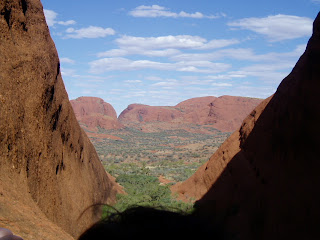
(KATA TJUTA)

(SUNRISE)

(ULURU)
It sparkled beneath the sunlight like a bloodstone ruby, Uluru, one of Aboriginal Australia’s most revered and sacred monuments. Amidst its grandeur, I stood in awe of this natural wonder as it towered above the desert sands like a rock solid ice burg that’d been washed ashore millions of years ago.
I waited with my fellow entourage of tourists, sipped champagne and watched as the sun took its final breath. Pink and purple sun rays danced across the surface of the rock, scorched the desert sands and illumined the sky for the final time that day. People gasped in awe, the sun fell out of sight, clouds slowly congregated above and the land went quiet.
Uluru is located southwest of Alice Springs, along with the worn rock peaks of Kata Tjuta, in the World Heritage listed: Uluru-Kata Tjuta National Park.
The beginnings of these natural wonders began more than six million years ago. Despite the region’s prehistoric history, modern archeological evidence suggests that the earliest human inhabitants around the area began 10, 000 years ago. To the Angu people, the beginnings of the reigon are much older than that and began with The Dreamtime, or the Dreaming. To the people of the land, this term refers to the “time before time” in which creation really began. According to legend, totemic beings, goannas, serpents and others, were the ones who helped to create the land, while humans existed eternally as a “spirit-child.” For any modern day visitor, it is quite amazing to see first hand evidence of Aboriginal Dreaming immortalized in the caves and crevices that surround Uluru and the area.
We were up before the sun. The sky was dark and the only sounds that could be heard were the nocturnal chirpings and low mumbled growls of nature. Ten of us, each spanning from different corners of the globe, stumbled about in our tents and quickly finished our morning tea, each anxious and excited that we were about to partake in one of the most sought after events in Australia’s red center region, sunrise at Uluru.
Uluru towers above the land at an astounding 348 feet. According to some experts, the size of this gigantic rock is nothing compared to the amount of rock that extends below the desert sands, with some suggesting it reaches down an extra 600 feet. Contrary to such speculation, other researchers presume the rock itself is connected to the Olgas which are on the opposite side of the desert.
An eerie silence enveloped us all. I took the window seat and watched as the morning sky slowly began to swallow the night. A sense of mystery and intrigue enveloped the desert sands as the rhythmic beats from the didgeridoo filled the air of our bus. No one said a word. Our tour guide turned around, did a quick head count, shut the doors and we set off down the road until we disappeared past our camp ground and back out into civilization.
The mysterious cawing of the cockatoo echoed throughout the land. We pulled into the sunset viewing area and our tour guide backed in our bus. I walked slowly down the stairs and out into the cold morning air. The skies above mutated from purple to orange as nothing but the sounds of nature and the low mumbled whispers from tourists could be heard across the red desert sands. My friends and I headed towards the group of people who’re lined along either side of the road, armed with every sized camera imaginable.The sun slowly rises, people stop what they’re doing to enjoy the show, and an almost instinctive spiritual reverence for this monolithic structure is quietly bestowed upon us.
.
No comments:
Post a Comment